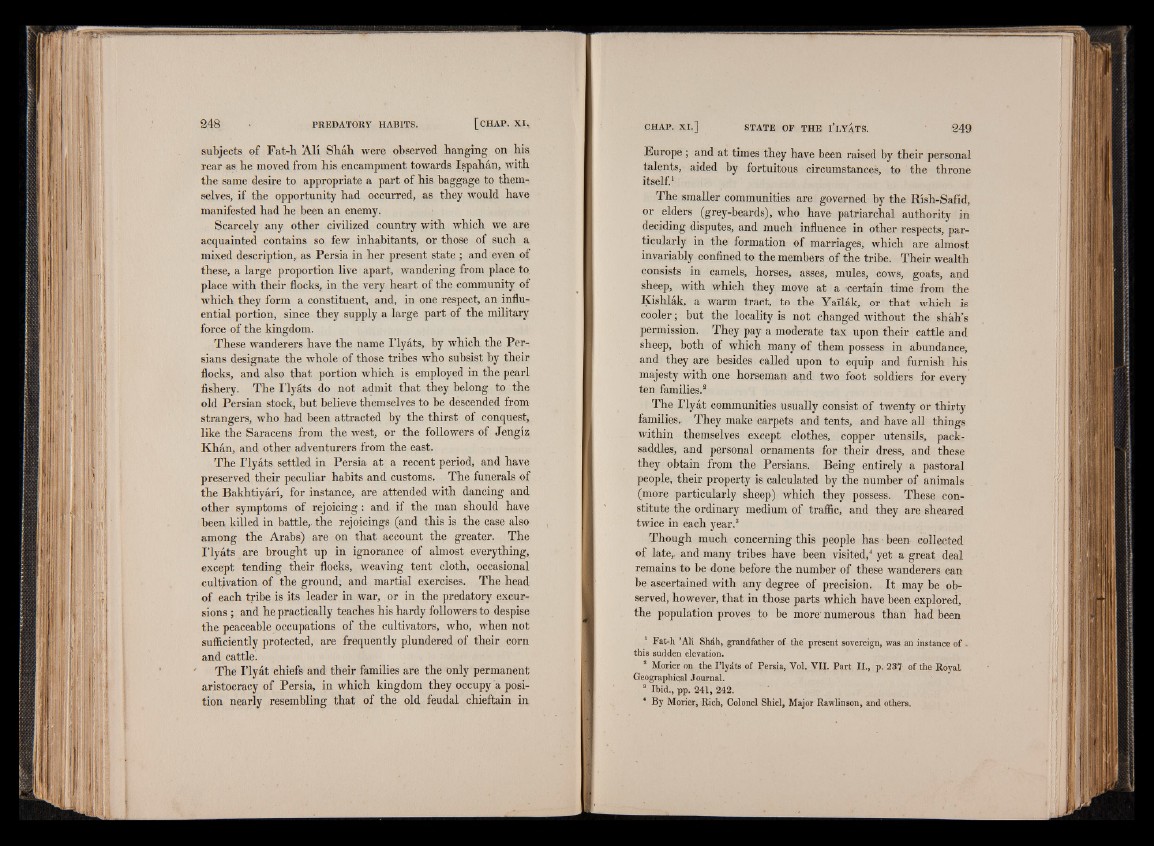
subjects of Fat-h Ali Shall were observed hanging on his
rear as he moved from his encampment towards Ispahan, with
the same desire to appropriate a part of his baggage to themselves,
if the opportunity had occurred, as they would have
manifested had he been an enemy.
Scarcely any other civilized country with which we are
acquainted contains so few inhabitants, or those of such a
mixed description, as Persia in her present state ; and even of
these, a large proportion live apart, wandering from place to.
place with their flocks, in the very heart of the community of
which they form a constituent, and, in one respect, an influential
portion, since they supply a large part of the military
force of the kingdom.
These wanderers have the name I’lyats, by which the Persians
designate the whole of those tribes who subsist by their
flocks, and also that portion which is employed in the pearl
fishery. The I’lyits do not admit that they belong to the
old Persian stock, but believe themselves to be descended from
strangers, who had been attracted by the thirst of conquest,
like the Saracens from the west, or the followers of Jengiz
Khan, and other adventurers from the east.
The I’lyats settled in Persia at a recent period, and have
preserved their peculiar habits and customs. The funerals of
the Bakhtiyari, for instance, are attended with dancing and
other symptoms of rejoicing: and if the man should have
been killed in battle, the rejoicings (and this is the case also
among the Arabs) are on that account the greater. The
I’lyats are brought up in ignorance of almost everything,
except tending their flocks, weaving tent cloth, occasional
cultivation of the ground, and martial exercises. The head
of each tribe is its leader in war, or in the predatory excursions
; and he practically teaches his hardy followers to despise
the peaceable occupations of the cultivators, who, when not
sufficiently protected, are frequently plundered of their corn
and cattle.
The I’lyat ehiefs and their families are the Only permanent
aristocracy of Persia, in which kingdom they occupy a position
nearly resembling that of the old feudal chieftain in
Europe; and at times they have been raised by their personal
talents, aided by fortuitous circumstances, to the throne
itself.1
The smaller communities are governed by the Rish-Safid,
or elders (grey-beards), who have patriarchal authority in
deciding disputes, and much influence in other respects, particularly
in the formation of marriages, which are almost
invariably confined to the members of the tribe. Their wealth
consists in camels, horses, asses, mules, cows, goats, and
sheep, with which they move at a certain time from the
Kishlak, a warm tract, to the Yallak, or that which is
cooler; but the locality is not changed without the shah’s
permission. They pay a moderate tax upon their cattle and
sheep, both of which many of them possess in abundance,
and they are besides called upon to equip and furnish his
majesty with one horseman and two foot soldiers for every
ten families.5
The I’lyat communities usually consist of twenty or thirty
families. They make carpets and tents, and have all things
within themselves except clothes, copper utensils, pack-
saddles, and personal ornaments for their dress, and these
they obtain from the Persians. Being entirely a pastoral
people, their property is calculated by the number of animals
(more particularly sheep) which they possess. These constitute
the ordinary medium of traffic, and they are sheared
twice in each year.3
Though much concerning this people has been collected
of late,, and many tribes have been visited,4 yet a great deal
remains to be done before the number of these wanderers can
be ascertained with any degree of precision. It may be observed,
however, that in those parts which have been explored,
the population proves to be more numerous than had been
1 Fat-h ’All Shdh, grandfather of the present sovereign, was an instance of .
this sudden elevation.
a Morier on the I ’lyats of Persia, Vol. VI.I. Part II., p. 237 of the Royal
Geographical Journal.
8 Ibid., pp. 241, 242.
4 By Morier, Rich, Colonel Shiel, Major Rawlinson, and others.